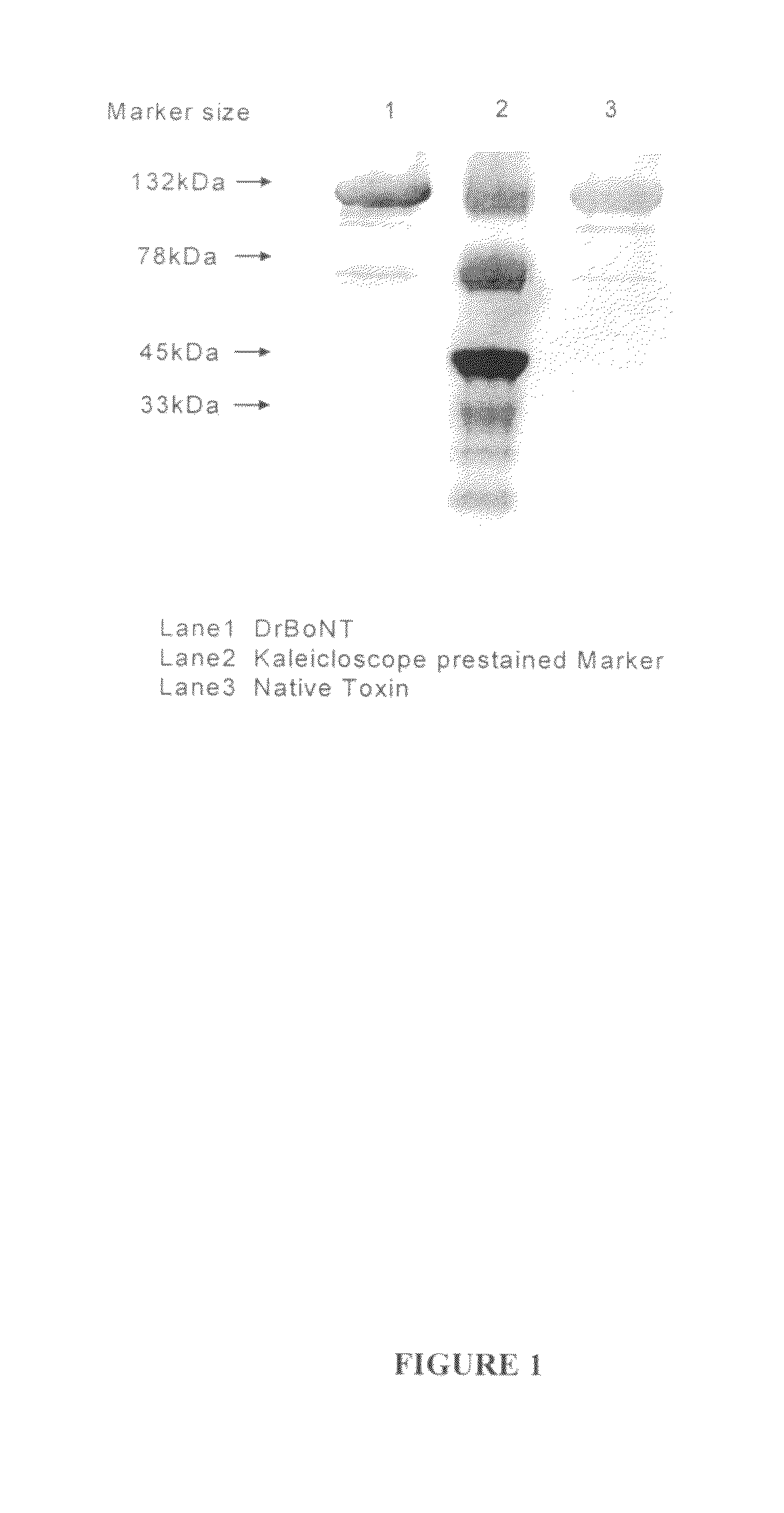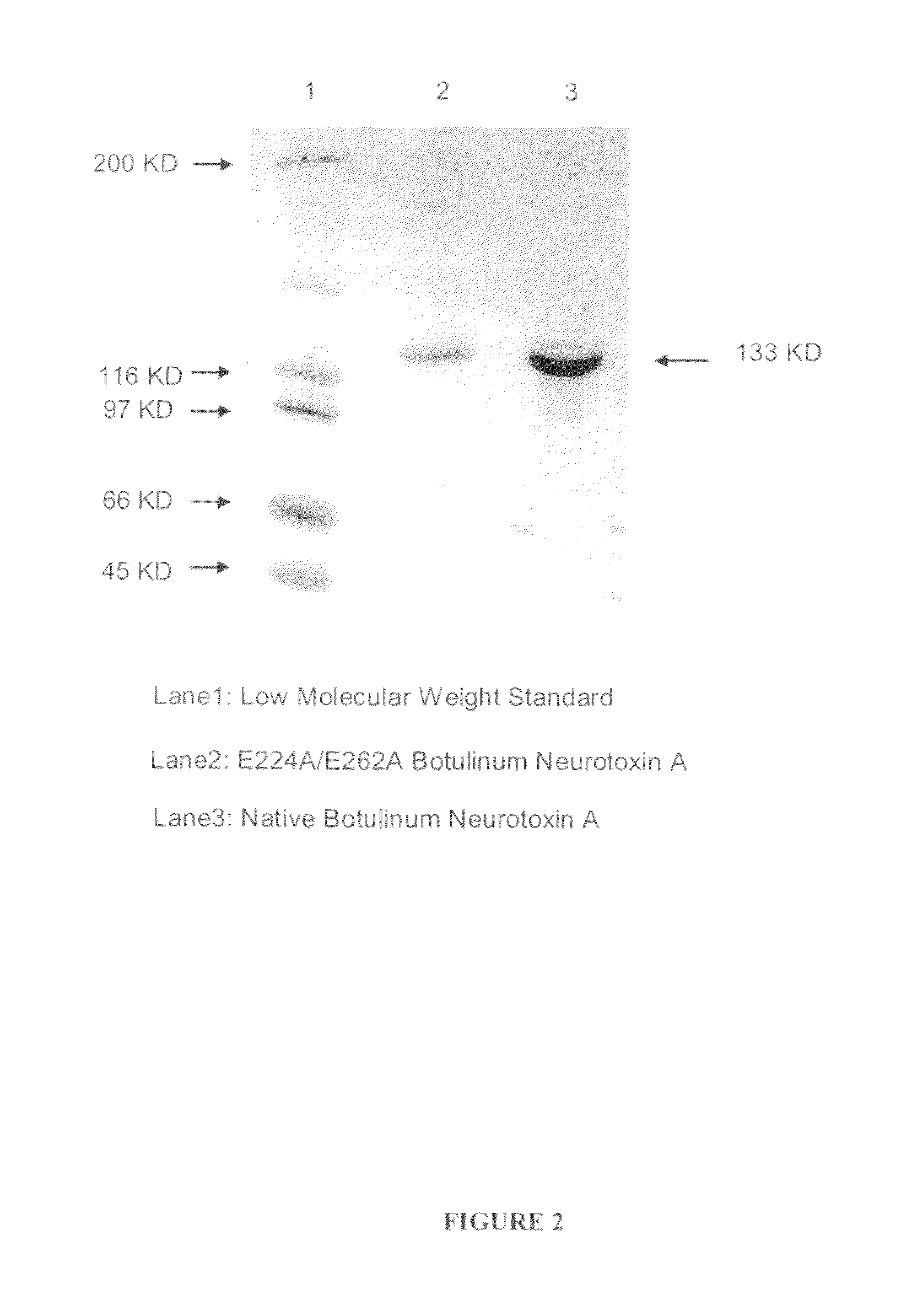Detoxified recombinant botulinum neurotoxin
a technology of clostridium botulinum and neurotoxin, which is applied in the field of detection, isolating, and using clostridium botulinum neurotoxin derived amino, can solve the problems of serious association, and achieve the effect of improving the stability of the protein of interest and/or facilitating the purification of the fusion protein
- Summary
- Abstract
- Description
- Claims
- Application Information
AI Technical Summary
Benefits of technology
Problems solved by technology
Method used
Image
Examples
example i
Designing and Construction of E224A / E262A BoNT / A Plasmid
[0202]Genomic DNA of BoNT / A was isolated from C. botulinum Hall strain. The strategy to construct the full length BoNT / A mutant was to fuse BoNT / A-HC into the LC which is already cloned into the pBN3 vector between the EcoRI and PstI sites. The plasmid pBN3 harboring E224A / E262A BoNT / A-LC gene was first constructed based on the E224A single mutant LC constructed previously (Li et al., Biochemistry 39, 2399-2405 2000). A single restriction site of Bsu36I was located at the end of LCA sequence. There is no Bsu36I cutting site in the pBN3 vector, which allowed for the use of Bsu36I and Pst I restriction enzymes to cut the pBN3 vector, containing the LCA gene, producing a sticky end for HCA to be ligated. Using forward primer that matches the base pairs of LCA 3′-end with Bsu36I restriction site and reverse primer which is matched with HCA 3′-terminal with built-in 6×His-tag sequence as well as a PstI restriction enzyme site, PCR w...
example ii
Primer Design and PCR Reaction
[0203]To create HCA gene with N-terminal overlap with C-terminal of the LCA both forward and reverse primers were designed as follows. The forward primer with Bsu36I site was: 5′-GGCCGCCCCGGGCGATAAAT ATAGTACCTAAGGTAAATTACAC-3′ (SEQ ID NO: 1), and the reverse primer with 6×His-tag and Pst I site was: 5′-AAATTATAATAAACTGCAGG CCTTAGTGATGGTGATGGTGATGCCCGGGAGTTGGCGGGGCCTTCAGTGGCCTTT CTCCCCATCCATCATC-3′ (SEQ ID NO:2). The PCR reactions were performed in 25 μl total volume containing Accuprimer Pfx Supermix, with 200 μM final concentration of each primer, and 300 ng Clostridium botulinum type A genomic DNA as template. The PCR sample was preheated at 95° C. for 5 min and then 35 cycles of PCR were performed: 95° C. for 15 seconds, 65° C. for 30 seconds and 68° C. for 2 minutes 48 seconds. After the last cycle, the reaction was incubated for an additional 10 min at 68° C. and 4° for storage.
example iii
Cloning HCA Gene into the pBN3 Vector
[0204]The PCR product was purified using the gel extraction kit (Qiagen, Valencia, Calif.) to remove the excess primers, enzyme, and template and then double digested with Bsu36I and Pst I (New England Bio-Lab, Beverly, Mass.) restriction enzymes in NEB buffer 3. After double digestion, digested products were separated by running-electrophoresis on a low melting point agarose gel and expected band was cut and purified by gel extraction kit. The products were then ligated overnight at 16° C. to the Bsu36I and Pst I digested and dephosphorylated pBN3 vector containing the LCA gene, by using the T4-ligation kits (Novagen, Damstadt, Germany). The ligated reaction mixture was transformed into the E. coli One shoot Top10 competent cells (Invitrogen, Carlsbad, Calif.), and plated on to a LB-agar plate with 100 μm / ml ampicilin for overnight growth. About 100 colonies were obtained from the plate. Several single colonies were picked up to grow overnight i...
PUM
| Property | Measurement | Unit |
|---|---|---|
| weight | aaaaa | aaaaa |
| pH | aaaaa | aaaaa |
| pH | aaaaa | aaaaa |
Abstract
Description
Claims
Application Information
 Login to View More
Login to View More - R&D
- Intellectual Property
- Life Sciences
- Materials
- Tech Scout
- Unparalleled Data Quality
- Higher Quality Content
- 60% Fewer Hallucinations
Browse by: Latest US Patents, China's latest patents, Technical Efficacy Thesaurus, Application Domain, Technology Topic, Popular Technical Reports.
© 2025 PatSnap. All rights reserved.Legal|Privacy policy|Modern Slavery Act Transparency Statement|Sitemap|About US| Contact US: help@patsnap.com



